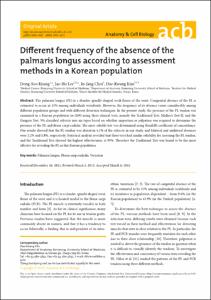Different frequency of the absence of the palmaris longus according to assessment methods in a Korean population
- Keimyung Author(s)
- Lee, Jae Ho; Choi, In Jang; Kim, Dae Kwang
- Department
- Dept. of Anatomy (해부학)
Dept. of Medical Genetics (의학유전학)
Institute for Cancer Research (암연구소)
- Journal Title
- Anatomy & Cell Biology
- Issued Date
- 2012
- Volume
- 45
- Issue
- 1
- Abstract
- The palmaris longus (PL) is a slender, spindle-shaped weak flexor of the wrist. Congenital absence of the PL is
estimated to occur in 15% among individuals worldwide. However, the frequency of its absence varies considerably among
diff erent population groups and with diff erent detection techniques. In the present study, the presence of the PL tendon was
examined in a Korean population (n=269) using three clinical tests, namely the Traditional Test, Mishra’s Test II, and the
Gangata Test. We classifi ed subjects into six types based on whether inspection or palpation was required to determine the
presence of the PL and fl exor carpi radialis. Th e most reliable test was determined using Kendall’s coeffi cient of concordance.
Our results showed that the PL tendon was absent in 4.1% of the subjects in our study, and bilateral and unilateral absences
were 2.2% and 1.8%, respectively. Statistical analysis revealed that these tests had similar reliability for assessing the PL tendon,
and the Traditional Test showed the highest effectiveness, at 93%. Therefore the Traditional Test was found to be the most
eff ective for revealing the PL in this Korean population.
Key words: Palmaris longus, Flexor carpi radialis, Variation
- Publisher
- School of Medicine
- Citation
- Dong-Soo Kyung et al. (2012). Different frequency of the absence of the palmaris longus according to assessment methods in a Korean population. Anatomy & Cell Biology, 45(1), 53–56. doi: 10.5115/acb.2012.45.1.53
- Type
- Article
- ISSN
- 2093-3665
- 파일 목록
-
-
Download
 oak-aaa-00212.pdf
기타 데이터 / 91.8 kB / Adobe PDF
oak-aaa-00212.pdf
기타 데이터 / 91.8 kB / Adobe PDF
-
Items in Repository are protected by copyright, with all rights reserved, unless otherwise indicated.